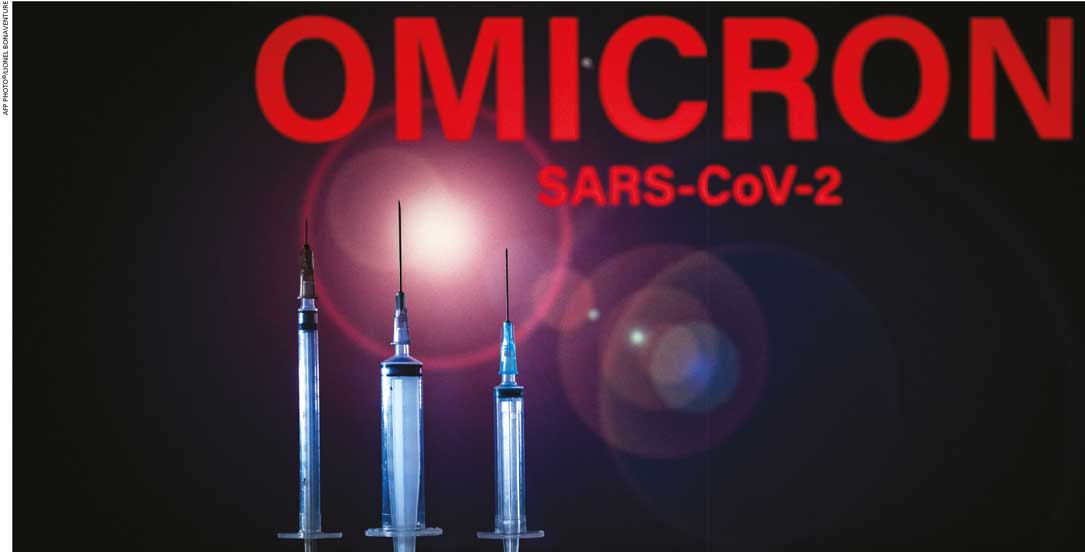OMICRON WARNING
LATEST MUTANT TO JOIN THE VIRAL PARTY!
Saro Thiruppathy reports on the spread of the Omicron variant and what the people of the world have to contend with at the dawn of a new year

At the rate that SARS-CoV-2 is mutating, one wonders whether the WHO will run out of Greek letters to allocate to the different variants of concern (VOC) that keep jumping out… seemingly out of nowhere.
In relation to naming the newest variant ‘Omicron,’ the World Health Organization says that seven VOCs that are currently in circulation have each been given a Greek letter as its name. Not all variants are important enough to be classified and apparently, the WHO also skipped the Greek letters ‘Nu’ and ‘Xi’ that precede Omicron.
In response to the curiosity expressed as to why the WHO skipped using Nu and Xi, the agency’s spokesman Tarik Jašarević explained that Nu can be easily confused with ‘new’ and ‘Xi’ is a common surname.
He also noted that under the WHO’s best practices, the organisation avoids causing offence to any cultural, social, national, regional, professional or ethnic group.
DISCOVERY Omicron (B.1.1.529) was first discovered in Botswana on 11 November; and then on 14 November, the variant was sighted in South Africa. Since then, it has spread across many parts of the world.
This VOC is still being studied and the thinking at this stage is that it will spread more easily than the original virus. But the rate of infection in comparison to Delta is yet unknown. What’s concerning is that even those who have been vaccinated can spread the disease irrespective of whether they display symptoms or not.
Scientists are studying the mutated virus but believe that vaccines that are currently available are effective in protecting people against experiencing severe infection and needing hospitalisation or even succumbing to it – as in the case of the Delta variant.
PROTECTION Continuing with the vaccination programme, which includes boosters, is also advised to prevent the worst case scenario of hospitalisation and death. Nevertheless, since the genetic makeup of Omicron is extremely complex, there is concern as to whether the same treatment afforded to COVID-19 patients will be as effective.
The US Centres for Disease Control and Prevention (CDC) is gathering data and samples of the virus; and apparently, experiments are already underway.
Scientists are using genomic surveillance to track the different variants of the SARS-CoV-2 virus and sharing genomic sequence data that’s been gathered by them, laboratories and diagnostic labs within databases that can be accessed by the public. These include ones that are maintained by the National Center for Biotechnology Information (NCBI) and Global Initiative on Sharing Avian Influenza Data (GISAID).
Since the Omicron variant was first discovered in Botswana in mid-November, it spread to some 60 countries within a month. So even if nothing else is known about it, the fact that the virus is being transmitted by travellers carrying vaccine passports has been established. On 13 December, the UK announced its first death as a result of Omicron – until then, there had been no deaths reported and no cases where patients required oxygen.
TRANSMISSION The WHO says that while Omicron has spread rapidly due to travel, there’s a possibility that this may change as more data becomes available.
Executive Director of the WHO Health Emergencies Programme Dr. Michael Ryan notes that even though Omicron is quite efficient at rapid transmission (much faster than Delta), it doesn’t mean that the virus cannot be contained.
However, even if Omicron is not as dangerous as Delta, the global health system is at breaking point and another round of hospitalisations can have a seriously detrimental effect on countries’ healthcare provisions.
Vaccines and masks are still offering protection against experiencing a fully blown infection. The WHO maintains that more data is needed to assess whether the mutations appearing on Omicron could end up reducing the immunity gained through vaccination. The world’s health authority is studying the data on the effectiveness of the vaccine as well as booster doses.
Seroprevalence is the level of pathogen found in a particular population as measured in blood serum. In South Africa, seroprevalence is 60-80 percent and vaccine coverage is only 35 percent. Omicron is particularly worrisome because it poses the threat of reinfection as well.
Commenting on the severity of this variant, the WHO notes that even if it is equal or lower than that of its predecessor Delta, there’s a strong possibility that if more infections are detected then there’s a chance that hospitalisations will increase.
Post analysing the data of 212 cases of Omicron in 18 EU countries on 6 December, all the cases were reported to be mild. However, the European Centre for Disease Prevention and Control has issued a dire warning saying that if one percent of SARS-CoV-2 infections are the result of Omicron, there’s a strong possibility that it could be dominant in Europe sooner rather than later.
STEALTH VERSION It seems the viral party is in full swing as scientists recently discovered a ‘stealth version’ of the virus that PCR tests aren’t able to recognise.
Though it has many mutations similar to Omicron, this version lacks a particular genetic change that would normally enable PCR to identify positive cases. The stealth version was first seen among COVID-19 genomes that had been recently submitted by South Africa, Australia and Canada.



